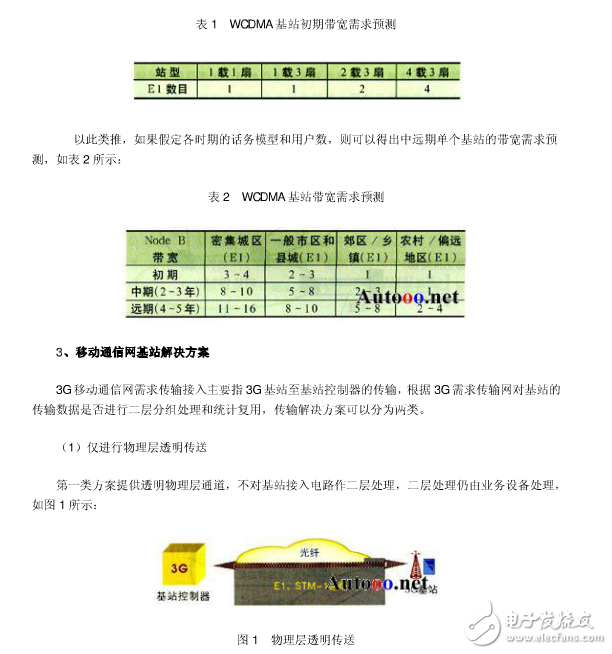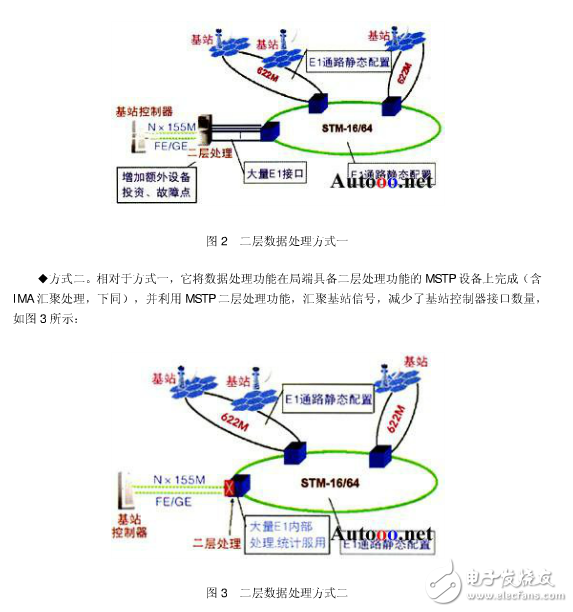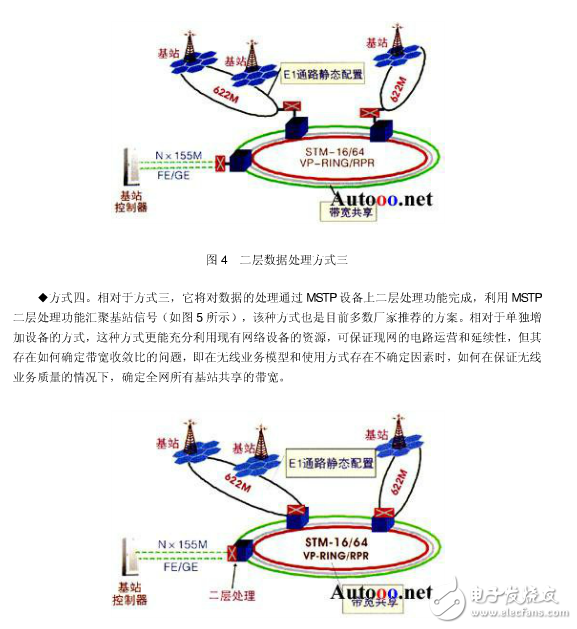Based on the analysis of the access requirements of 3G mobile communication network base stations, the paper analyzes and discusses the access schemes of 3G mobile network base stations, and puts forward suggestions for the initial construction of 3G base station transmission networks.
1 IntroductionThe development of the third generation of mobile communication (3G) has experienced the confusion of the selection of institutional standards and the number of licenses issued. This year, it has developed into the stage of equipment scale development, network scale testing, business application, industrial development and network construction planning. In the entire mobile communication network planning, the transmission network planning as the basic network will be the key factor affecting service opening, cost, network quality and scalability. Therefore, the transmission network planning and construction required for 3G mobile communication networks play an important role in the development of the entire 3G network.
At present, 3G mobile network technologies include three network standards: WCDMA, CDMA2000, and TD-SCDMA, and the network consists of a core network and a wireless network, respectively. The commercial version of WCDMA is R99 and R4. Among them, the R99 version adds PS packet data service, and the SCSN and GGSN form an all-IP packet switching network through a high-speed Ethernet interface or POS connection; the wireless network part between Node B and RNC passes ATM technology. Connections, voice services, and data services are carried in ATM cells. The R4 version of the wireless network part and the core network PS packet domain are the same as the R99, except that the control (MSC Sever) is completely separated from the switching plane (MGW media gateway) in the CS circuit domain, and the MGW can perform TDM, ATM, and IP. Way of business exchange. TD-SCDMA has little difference with WCDMA in interface and transmission mode, but there are differences in the implementation of wireless part. The CDMA2000 standard currently mainly refers to CDMA2000 EV-DO, and its transmission mode is basically the same as WCDMA. The three systems have their own advantages in terms of technical principles, radio frequency, air interface, coverage, network capacity, and service implementation. They also have their own characteristics in terms of network element setting and function partitioning, which will not be repeated here. However, from the perspective of transmission, in the structure of the mobile communication network, the interface and interface attributes of the three types of network elements are transmitted in a packetized manner, which is their common development direction. In terms of layered and divided bearer of the network, whether it is WCDMA, CDMA2000 or TD-SCDMA, the logical network structure of the 3G mobile communication network can be unified into two levels: the access network layer (UTRAN) and the core network layer (CN). The 3G transmission network mainly undertakes service aggregation from UTRAN to CN, and service transmission in the CN. This paper analyzes the transmission circuit requirements of 3G mobile communication network, and discusses the common problems of transmission network planning for 3G base station access.
2, 3G mobile communication network demand transmission circuit analysisThe requirements of the 3G mobile communication network for the transmission network are mainly reflected in the two aspects of transmission capacity and support for 3G service interfaces. The 3G transmission network is divided into two parts: the first part is the backbone transmission network, which is used to solve the service transmission of the 3G core network, which belongs to the provincial trunk line and the provincial trunk line; the second part is the local transmission network to solve the 3G wireless connection. The service transmission of the network belongs to the scope of the metropolitan area network/local network.
2.1 Core network requirements for backbone transmission
The need for transmission of the 3G core network includes the requirements between the core network elements, the core network, and the base station controllers of the radio access network, mainly referring to the transmission requirements of large granular STM-1, FE/GE/POS, etc., which have large particles, The characteristics of large bandwidth, simple intermediation, and high reliability are mainly transmitted by provincial and inter-provincial trunk lines.
At present, the technologies used in the provincial and inter-provincial trunk transmission networks are mainly SDH and WDM (some SDHs have MSTP functions), which can provide transmission rates from E1 to STM-16. Considering the trend of large-capacity setting of core network elements, in the general provinces and autonomous regions, the central office addresses are few, and the service flow is relatively simple. At present, the provincial and inter-provincial trunk lines can basically meet the 3G services. The demand, therefore, can only be expanded from the network capacity, and in the provinces and provinces with large traffic volume, you can consider the appropriate introduction of the network structure of the ASON network.
2.2 3G access network requirements for the transmission access layer
The part of the circuit mainly refers to the base station to the base station controller, and is generally transmitted by the local transmission network (including the metropolitan area transmission network). Among them, the circuit between the base station and the base station controller has a large number of base stations, a wide distribution, and a large total amount, which is a part that needs to be solved in transmission. At present, the base station controller and the core network element have a large capacity trend. In some areas, multiple local networks may jointly form a "large local network". Therefore, in this area, the circuit between the base station and the base station controller is required. Take it through the provincial trunk line.
The 3G wireless base station access network and the 2G are no different in the service flow direction, and are also centralized services with respect to the central office. The network architecture can still follow the layered and split networking mode of the 2G network transmission network. On the interface attributes, compared to the 2G network base station, the 3G network has not changed much recently, mainly based on the E1 interface. However, with the progress of IP, the interface of Ethernet IOM/100M will appear in the future. In view of the existing performance of various devices, it is a good choice to introduce an MSTP device with data processing function, and various access methods described below can be employed.
Another important factor to consider in the 3G access transport network networking is the capacity allocation of each base station and the system capacity planning of the transport network. At present, the more common capacity calculation method for base station access requirements is to adopt a hypothetical business model algorithm. Taking the capacity requirement of the Node B base station of the WCDMA network as an example, the calculation process of the capacity requirement of a single base station can be obtained as follows:
Assume that Node B corresponds to the Iub interface, and the total bandwidth is W=Ncell&TImes; (Nuser&TImes; Ev&TImes; 6.6 kb/s+Nuser&TImes; Ecs×64b/s+Nuser×Vps)×(1+Osig+Oo&m)×(1+Q) /(1/Y)
Ncell represents the number of cells; a single carrier frequency omnidirectional base station is one cell; a single carrier three base stations is three cells; two carriers three base stations are six cells; and so on:
â—† Nuser is the number of users in the cell.
â—† Ev is the number of Irish voices per user.
â—† Ecs is the number of Irish phones per user.
â—† Vps is the average data rate per user.
â—†Osig is the overhead of control signaling, taking 10%.
â—† Oo&m is the overhead for logical and physical operation maintenance, etc., 5%.
â—† Q is the overhead generated by ATM transmission, 10%.
â—†Y is the load factor, which is 80%.
â—† 6.6b/s and 64b/s are the occupied bandwidth of voice and video telephony services respectively.
Suppose a network's initial traffic model is:
â—† The number of users in the cell number Nuser is 1000.
â—† Ev is the number of Irish voices per user, which is 0.025.
â—† Ecs is the number of Irish calls per user, 0.001.
â—† Vps is the average data rate per user, taking 180b/s.
Based on the above data, the transmission bandwidth requirements of several typical configurations can be obtained, as shown in Table 1:
Table 1 Initial bandwidth demand forecast for WCDMA base stations
By analogy, if the traffic model and the number of users in each period are assumed, the bandwidth demand prediction of a single base station in the medium and long term can be obtained, as shown in Table 2:

The scheme has a clear interface for professional division of labor, and the processing of uncertainty and suddenness of data services is concentrated on the service equipment side. It adopts optical fiber direct connection and E1/STM-1 static path (including PDH, SDH and wireless microwave transmission networks). The link provided).
â—† Some base station equipments of wireless manufacturers can directly provide STM-1 optical ports to connect directly to the base station controller. However, if the optical fiber is directly connected, it will waste fiber, not in the form of network, and it is difficult to maintain and has low security. It should not be used.
â—† Through the channelized STM-1 static transmission, the above problems also exist. However, when there are uncertain factors in the 3G service for a long time, the bandwidth will be largely idle, resulting in low interface utilization, which is not suitable.
(2) Layer 2 data processing
The second type of scheme is to perform Layer 2 processing on the base station access circuit for statistical multiplexing and bandwidth sharing to improve transmission efficiency. At present, the industry has discussed more such programs. In general, according to the different signal processing positions and ranges, it can be divided into the following five application methods.
â—† Way one. It adds a layer 2 processing device to the central office base controller side, processes the base station signal, and converts it into a large granular interface to access the base station controller, which reduces the number of interfaces of the base station controller, as shown in FIG. 2 . This approach does not address the bandwidth pressure of the transport network, but adds additional equipment, points of failure, and maintenance.

â—† Method three. It extends the Layer 2 processing of data to the aggregation service node of the transport network aggregation layer. The bandwidth of the aggregation layer is shared, the bandwidth utilization of the aggregation layer is improved, and the bandwidth construction pressure of the aggregation layer network is reduced. A method of separately adding a data processing device at the aggregation node may be adopted, and the accessed base station signal is first connected to the data processing device to perform Layer 2 data convergence bandwidth, and then accesses the convergence layer network. This processing method adds additional equipment, and at the same time separates the structure of the transmission network from the perspective of signal transmission to separate the aggregation layer and the access layer. On the one hand, the adjustment of the existing network is large and the existing operation circuit is affected. On the other hand, the post-workload of the operation and maintenance site is increased, as shown in Figure 4:

â—† Method five. Compared with the fourth method, the data processing is extended to the edge layer MSTP device, and the MSTP layer 2 processing function is used to aggregate the base station signals and share the transmission network bandwidth to improve the bandwidth transmission efficiency (as shown in FIG. 6). Of course, another way is to build a separate data network. However, there are only a few operators in China that have ATM networks, and they are very incomplete. Newly built hundreds or even thousands of points of base station access coverage, from the perspective of economic efficiency. Unrealistic, there are also problems in the above methods.

In the above manner, the base station circuit signal is in the transmission path of the base station to the base station controller, and the layer 2 processing of the data is gradually advanced by the base station controller to the base station side, and the second layer processing of the data is gradually expanded to utilize the transmission circuit. Efficiency has also improved. The application of the second type of mode focuses on the allocation of shared bandwidth of each transmission path (ie, the convergence ratio is determined), which has a close relationship with the user service application model.
4, base station access solution recommendationsIt can be seen from the above analysis that in the 3G demand transmission network planning, the planning of the backbone network does not change much compared to the 2G network. The difficulty in planning lies in the transmission network accessed by the wireless base station, especially the allocation of bandwidth capacity after the introduction of the packet data service. . The packet characteristics of the data service result in the sudden and unpredictable transmission bandwidth, which can only be gradually improved through business operations, accumulating experience and correcting the model. At the same time, it is also a gradual process that operators and ISPs and ICPs must work tirelessly to gain wide acceptance and acceptance. If we consider that data services are from scratch, from small to large, the transmission network will face changes from low-capacity, small-particle, simple structure requirements to high-capacity, large-particle, complex structure requirements, which requires transmission network planning. It should have considerable scalability, especially in the initial stage of transmission network construction. Considering the economical and efficient type of transmission network construction, special attention should be paid to the scalability and sustainable construction of the transmission network to maintain the stable development of the transmission network.
Each of the above methods has its own characteristics and applicable occasions. However, considering that the mobile data service model is uncertain at the initial stage of 3G operation and the demand for bandwidth is not large, the following suggestions are made for the base station access problem of the 3G mobile network:
(1) In general, it is recommended to avoid the impact of the transmission network due to the large-scale increase of capacity by the scalability of the base station interface capacity; with the scalability of the transmission network, the transmission network construction has timeliness, stability, and continuity; Gradually make full use of the MSTP technology of the transmission network to process the packet data, improve the utilization efficiency of the transmission bandwidth, share the transmission bandwidth, and avoid the simple accumulation of the transmission capacity from the access layer to the aggregation layer circuit, thereby avoiding the huge network capacity.
(2) It is recommended that the 3G wireless base station equipment transmit the interface bandwidth to have smooth scalability. The processing of packet data should be unified by station, providing multiplexing functions for multiple sectors, and the number of transmission bandwidth interfaces provided can be smoothly expanded. For example, in the initial stage of the base station, only one or two E1s can be provided, and in the later stage, the bandwidth of the online transmission bandwidth channel is increased according to the traffic volume.
(3) It is recommended that in the initial stage of 3G network construction, the transmission of 3G base station access still allocates bandwidth in the form of static links to ensure service quality. At this time, the network can be quickly deployed to avoid large adjustments of the transmission network. For new mobile operators with less transmission resources, this method can also be adopted to fully utilize the advantages of rapid construction of wireless technologies such as microwave transmission and rapidly deploy networks.
(4) It is recommended to complete the overall planning of the transmission network based on the actual prediction of the medium and long-term network. It is preferred to set up the transmission network by MSTP technology, especially for the planning of the backbone aggregation layer, and to ensure the timeliness of investment in the construction of the transmission network. Also, we must ensure the smooth development of the transmission network. Should actively participate in the transmission network and data network convergence, accumulate data service bandwidth operation and maintenance experience, especially bandwidth management, reuse management.
(5) It is suggested that with the increase of network scale, the above-mentioned second-class schemes will be gradually implemented. According to the development of mobile data services, the use of Layer 2 processing functions will be gradually expanded to improve transmission efficiency, and the main business of circuit services will be completed. Smooth transition.
The through-wall terminals can be installed side by side on panels with thicknesses ranging from 1mm to 10mm, and can automatically compensate and adjust the thickness of the panel to form a terminal block with any number of poles. In addition, isolation plates can be used to increase air gaps and creepage distances.
Through-Wall Terminal,Through Wall Terminal Block,Through-Wall Terminal Extender,Through-The-Wall Terminal Block
Sichuan Xinlian electronic science and technology Company , https://www.sztmlchs.com